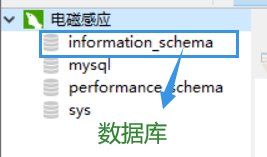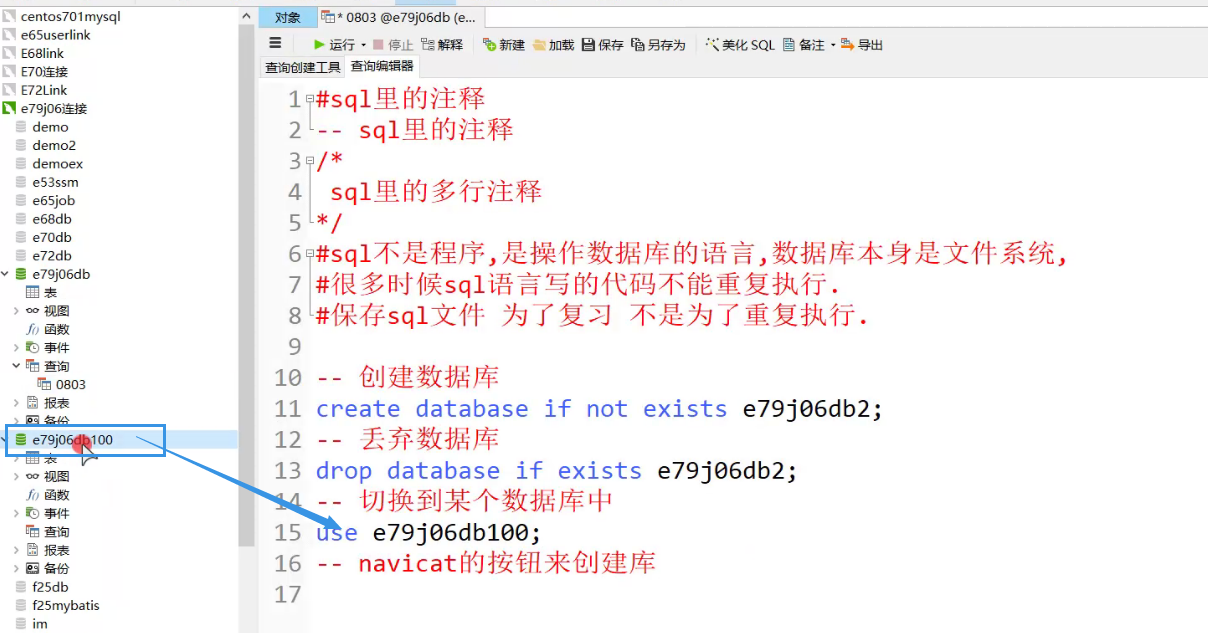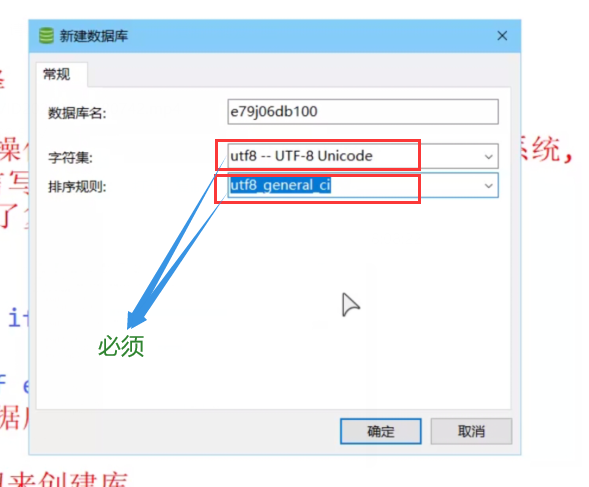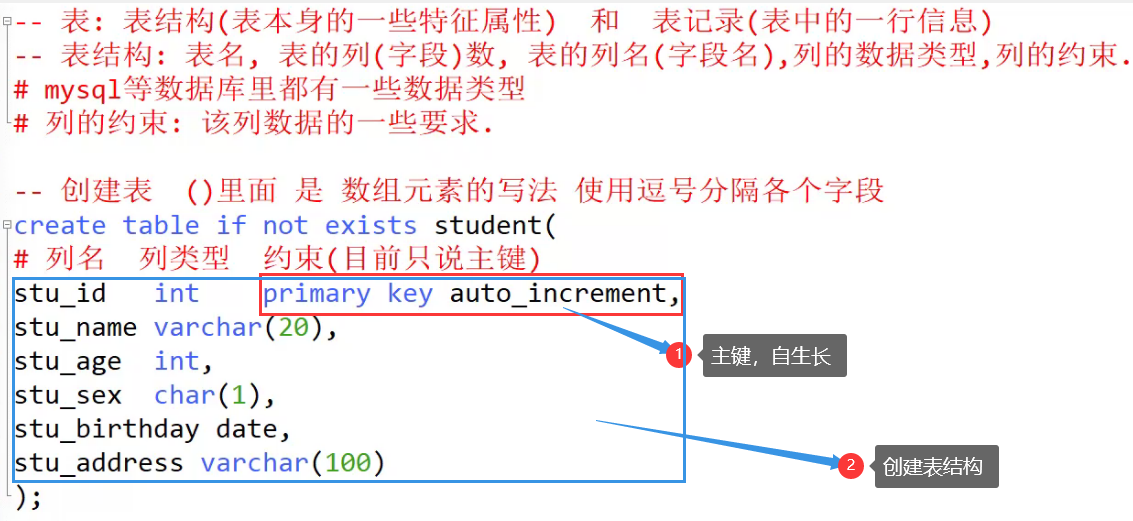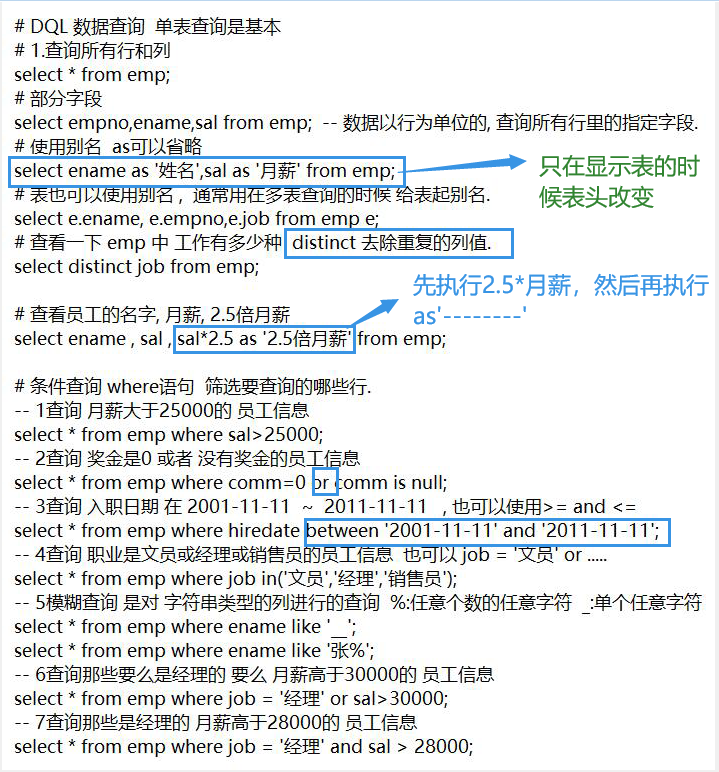Nature of database:
-
A data storage method that can permanently save and query fast data storage.
Three connection methods of database server:
-
Open through management service

-
Open through the graphical user interface (navicat).
-
Open through the upper triangle of the taskbar.

Diagram:
Database:
table:
-
Each row is called a record
-
Each column is called a field
-
Generally, you need to specify how many columns there are, and you don't need to specify how many rows there are
Basic commands for database operation:
-
Display all database files on the database server: show databases database names
-
Create database: create database database name
-
Delete the database; drop database database name
- Switch database: use database name
Graphical user interface creation:
SQL syntax:
-
Keywords are case insensitive and generally lowercase
-
sql statements cannot be run repeatedly
Classification of SQL syntax:
-
Data Definition Language (DDL data definition language) such as: building databases and tables.
-
Data Manipulation Language(DML), such as adding, deleting and modifying records in a table.
-
Data Query Language(DQL), such as query operations on tables.
-
Data Control Language(DCL), such as setting of user permissions.
Data type: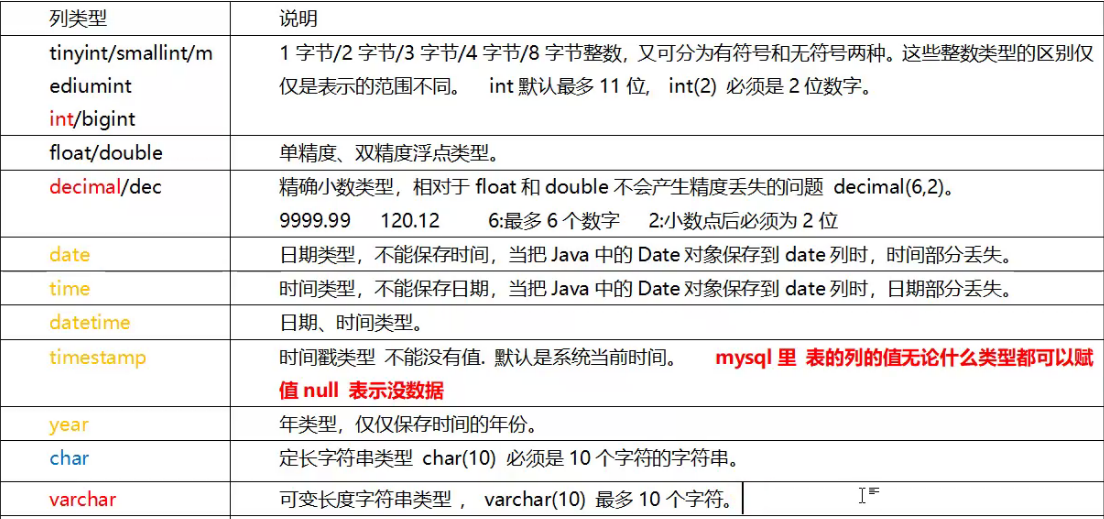

DDL:
Create table:
be careful:
- The data type of date can be passed to string. When comparing dates, you can compare strings.
- For fields, multiple constraints can exist at the same time, such as stu_id .
Copy table contents:
View table structure (header):
desc table name;
Delete table:
drop table if exists table name;
Modify table structure (alter):
Note: This is a column operation.
DDM: (modify record)
Add: (insert into---values)
After specifying the primary key sequence, when adding it again, it will start from the specified primary key sequence .
Modify: (update---set)

Delete: (delete from---where)
Note: if the where filter condition is not added during deletion, the entire table will be deleted, and the deletion preserves the primary key sequence (that is, if a new row is added, the primary key will not start from the beginning, but follow the original sequence)
truncate does not retain the primary key sequence:
Logical deletion:

Data constraints:
Note: null means that there is no value and there is no duplication
 Add constraints when creating tables: (multiple constraints can decorate one)
Add constraints when creating tables: (multiple constraints can decorate one)
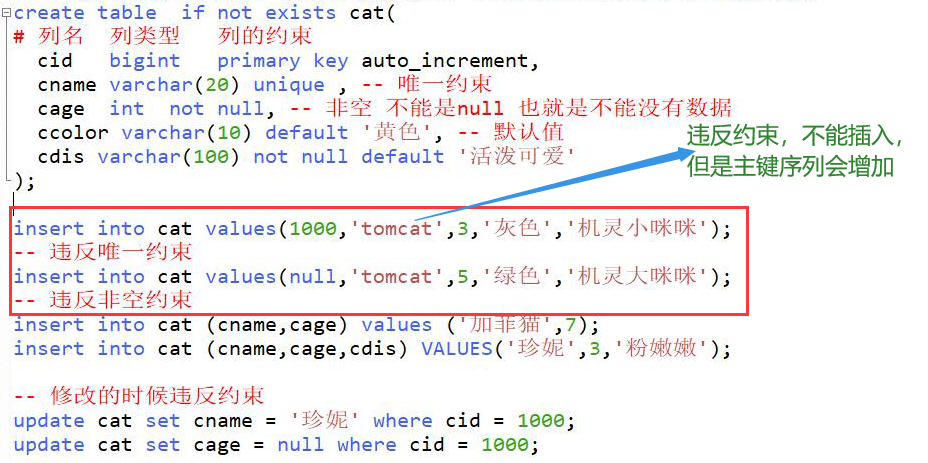
For columns with self incrementing primary key (only integer int), when all elements are inserted, the primary key is null.
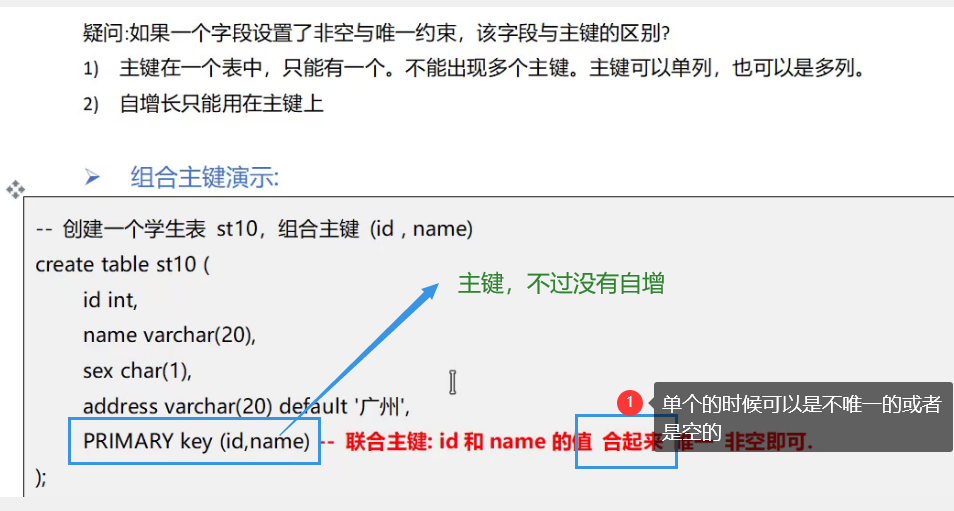
Operate primary key in existing table:
--Delete the primary key of st5 table
alter table st5 drop primary key;
--Add primary key
alter table st5 add primary key(id);
Foreign key constraints:
- What it is: a foreign key is a way to create a direct relationship between a table and a table. A column of a foreign key connected slave table can only be one of the primary key values of the primary table. There can only be one master table and multiple slave tables. Foreign keys are the bridge between master tables and slave tables.
- Create foreign key when creating table: [CONSTRAINT] [foreign key CONSTRAINT name] foreign key REFERENCES Primary table name (primary key field name)
- Create FOREIGN KEY in existing table: ALTER TABLE From the table ADD [CONSTRAINT] [FOREIGN KEY constraint name] FOREIGN KEY REFERENCES Primary table (primary key field name);
- Cascade operation: when modifying and deleting the primary key of the primary table, the foreign key value of the secondary table is updated or deleted at the same time, which is called cascade operation
| Cascading operation syntax | describe |
| ON UPDATE CASCADE | Cascading updates can only create cascading relationships when creating tables. Update the primary key in the main table and remove the foreign key from the table Columns are also automatically updated synchronously |
| ON DELETE CASCADE | cascading deletion |
| ON DELETE SET NULL | Set the foreign key field from the table to NULL when deleting |
Foreign key deletion: ALTER TABLE drop foreign key from table Foreign key constraint name;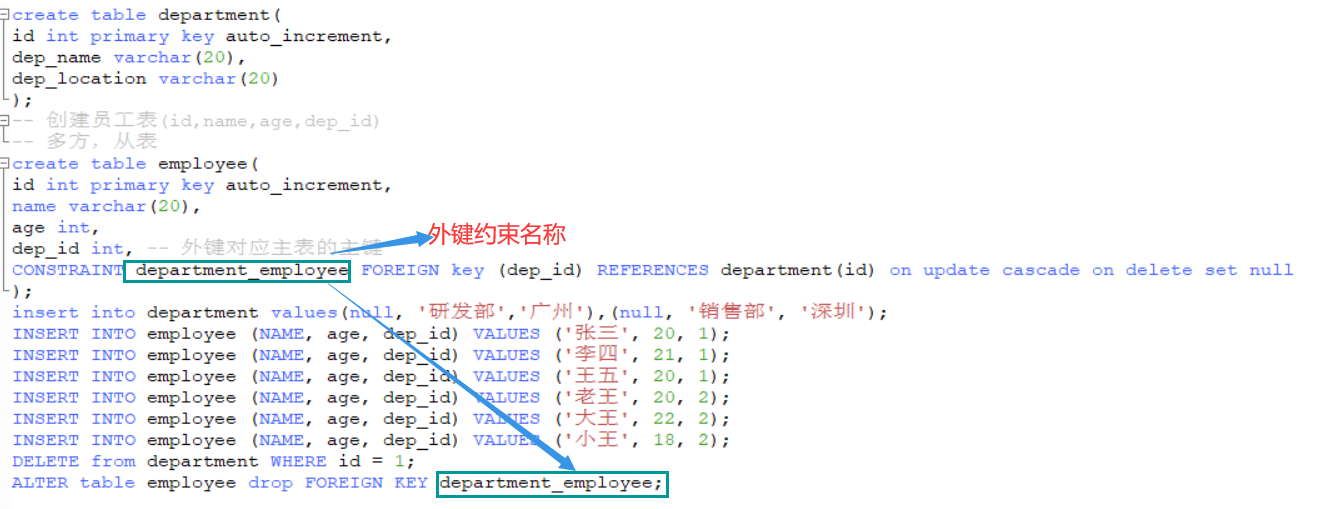
Example: (foreign keys are created from above the table)
Create master table B:

Create from table A: (cascade delete and cascade update are set)
Insert value from table:

Delete:

DQL : (query)
Basic syntax:
SELECT [ALL | DISTINCT]
{* | table.* | [table.field1[as alias1][,table.field2[as alias2]][,...]]}
FROM table_name [as table_alias]
[left | right | inner join table_name2] -- Joint query
[WHERE ...] -- Specify the conditions to be met for the results
[GROUP BY ...] -- Specify which fields the results are grouped by
[HAVING] -- Secondary conditions that must be met to filter grouped records
[ORDER BY ...] -- Specifies that query records are sorted by one or more criteria
[LIMIT {[offset,]row_count | row_countOFFSET offset}];
-- Specify which records to query from
be careful : [ ] Brackets represent optional , { }Parentheses are requiredDifference between where and having: where is to filter according to conditions before splitting calculation. Having is to filter according to the table requirements during consolidation.
-- Query the average score of different courses,Highest score,Lowest score -- premise:Group according to different courses SELECT subjectname,AVG(studentresult) AS average,MAX(StudentResult) AS Highest score,MIN(StudentResult) AS Lowest score FROM result AS r INNER JOIN `subject` AS s ON r.subjectno = s.subjectno GROUP BY r.subjectno HAVING average>80; /* where Write before group by If the filter is placed after the group To use HAVING Because having filters from the previously filtered fields, and where filters directly from the fields in the data table */
Distinct keyword (de duplication) select distinct sex from emp; (those with the same gender will be deleted)
like keyword: (fuzzy query)
SELECT * FROM Table name WHERE Field name LIKE 'wildcard string';
| % | Match multiple characters |
| _ | Match one character |
Descending and ascending: (similar to prepositional phrases)
- asc: ascending order;
- desc: descending order;

Combined sort: sort the items in parallel according to the former first. If the former is the same, then sort according to the latter.
desc: (another meaning is to view the table structure)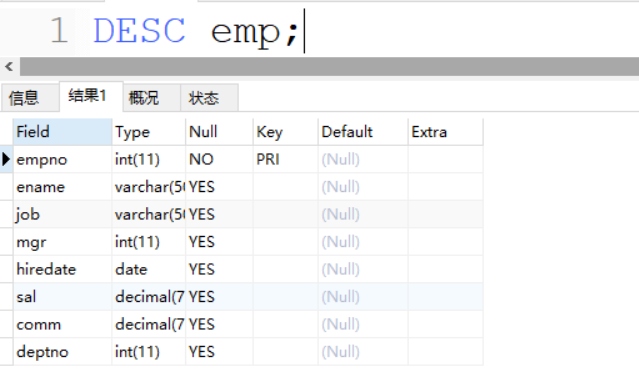
Aggregate function query: (vertical query = = > used to count the number)
Five aggregate functions:
| Aggregate functions in SQL | effect |
| Max (column name) | Find the maximum value of this column |
| Min (column name) | Find the minimum value of this column |
| AVG (column name) | Find the average of this column |
| Count (column name) | Count how many records there are in this column |
| Sum (column name) | Sum this column |

Note: if a column in the statistics has NULL (empty), the function will not be included in the statistics. For statistical count (*), only if all of a row are empty, it will not be counted.
About null operation: the result of null and all other data calculation is still null, so in some cases, it is necessary to convert null into 0 or 1. Use ifnull (a, b) statement. When false, this is a, and when true, this is B;

group by - (similar prepositional phrase)

Note: where precedes group by.
Paging query: limit x, y (where X represents the starting page of this page and Y represents the number of records on this page) (similar to prepositional phrases)
?????? Note: the index starts at 0.
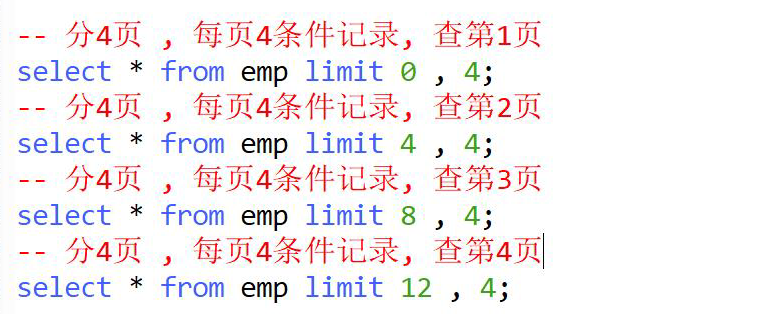
The following is to arrange the whole table in descending order of hieredate, and then page it.
Index: (speed up query) look at this: Crazy God says MySQL learning notes_ Straw hat Luffy caused by interest - CSDN blog_ Crazy God said MySQL notes https://blog.csdn.net/weixin_43591980/article/details/109526825
https://blog.csdn.net/weixin_43591980/article/details/109526825
effect:
- Improve query speed
- Ensure data uniqueness
- The connection between tables can be accelerated to realize the referential integrity between tables
- When using grouping and sorting clauses for data retrieval, the time of grouping and sorting can be significantly reduced
- Full text search field for search optimization

Create index manually:
DCL: 
We now use the root user and super administrator by default, with all permissions. However, the database server in a company
A database that may run many projects at the same time. Therefore, we should be able to establish different users according to different projects and assign different permissions to manage and maintain the database.
- Syntax:
| CREATE USER 'username' @ 'hostname' IDENTIFIED BY 'password'; |
- Keyword Description:
| keyword | explain |
| 'user name' | User name to be created |
| 'host name' | Specify the host on which the user can log in. If it is a local user, you can use localhost. If you want the user to log in from any remote host, you can use the wildcard% |
| 'password' | The login password of the user. The password can be blank. If it is blank, the user can log in to the server without a password |
demonstration:
| #To create a user1 user, you can only log in to the mysql server on the localhost server with a password of 123 #Create user2. The user can log in to the mysql server on any computer with a password of 123 create user 'user2'@'%' identified by '123'; |
Note: the created user names can be viewed in the user table in the mysql database, and the password is encrypted.
- Delete user syntax:
| DROP USER 'username' @ 'hostname'; |
demonstration:
| #Delete user user2 drop user 'user2'@'%'; |
- to grant authorization
- After the user is created, there is no permission! User authorization is required
| GRANT Permission 1, Permission 2... ON Database name. Table name TO 'user name' @ 'host name'; |
- Keyword Description:
| keyword | explain |
| GRANT...ON...TO | Authorization keyword |
| jurisdiction | Permissions granted to users, such as CREATE, ALTER, SELECT, INSERT, UPDATE, etc. If you want to grant If ALL permissions are granted, use ALL |
| Database name. Table name | Which tables in which database can the user operate. If you want to grant the user corresponding operation permissions on all databases and tables, it can be represented by *, such as ** |
| 'user name' @ 'host name' | Which user is authorized? Note: there are 2 pairs of single quotes |
demonstration:
| #User user1 is assigned permissions for demo database operations: create tables, modify tables, insert records, update records, and query grant create,alter,insert,update,select on demo.* to 'user1'@'localhost'; #Assign all permissions to user2 user to all tables of all databases grant all on *.* to 'user2'@'%'; |
- Revoke authorization syntax:
| REVOKE permission 1, Permission 2... ON Database. Table name revoke all on test.* from 'user1'@'localhost'; ' User name '@' host name '; |
| keyword | explain |
| REVOKE...ON...FROM | Keywords to revoke authorization |
| jurisdiction | The user's permissions, such as CREATE, ALTER, SELECT, INSERT, UPDATE, etc., all rights ALL only |
| Database name. Table name | For which databases and tables, if you want to cancel the user's operation permission on all databases and tables, it can be represented by *, such as ** |
| 'user name' @ 'host name' | To which user |
demonstration:
| #Revoke user user1's permission to operate on all tables in the demo database revoke all on demo.* from 'user1'@'localhost'; |
- View permission syntax:
| SHOW GRANTS FOR 'user name' @ 'host name'; |
demonstration:
| #View user1 user's permissions show grants for 'user1'@'localhost'; |
- Change Password
- Syntax:
| ALTER user 'username' @ 'hostname' IDENTIFIED by 'new password'; |
demonstration:
| #Change the password of the root user to root alter user 'root'@'localhost' IDENTIFIED by 'root'; |
Under MYSQL8 version The password encryption rules of the account need to be changed
| alter user 'root'@'localhost' IDENTIFIED with mysql_native_password by 'root'; |
| We use the root account To create and authorize users, Authorization itself is a privilege If we want to grant this permission to ordinary users, Grant.......................................... to user @ host address with grant option |
Multi table query:
give an example:
# Create department table
create table dept01(
id int primary key auto_increment,
name varchar(20)
);
insert into dept01 (name) values ('Development Department'),('Marketing Department'),('Finance Department');
# Create employee table
create table emp01 (
id int primary key auto_increment,
name varchar(10),
gender char(1), -- Gender
salary double, -- wages
join_date date, -- Entry date
dept_id int,
CONSTRAINT fx foreign key (dept_id) references dept01(id) -- Foreign key, related department table(Primary key of department table)
);
insert into emp01(name,gender,salary,join_date,dept_id) values('Sun WuKong','male',7200,'2013-02-24',1);
insert into emp01(name,gender,salary,join_date,dept_id) values('Zhu Bajie','male',3600,'2010-12-02',2);
insert into emp01(name,gender,salary,join_date,dept_id) values('Tang Monk','male',9000,'2008-08-08',2);
insert into emp01(name,gender,salary,join_date,dept_id) values('Baigujing','female',5000,'2015-10-07',3);
insert into emp01(name,gender,salary,join_date,dept_id) values('spider goblin','female',4500,'2011-03-14',1);
select * from emp01,dept01;#Two tables produce Cartesian product
select * from emp01,dept01 where emp01.dept_id = dept01.id;#filter
select emp01.name, dept01.name from emp01,dept01 where emp01.dept_id = dept01.id;
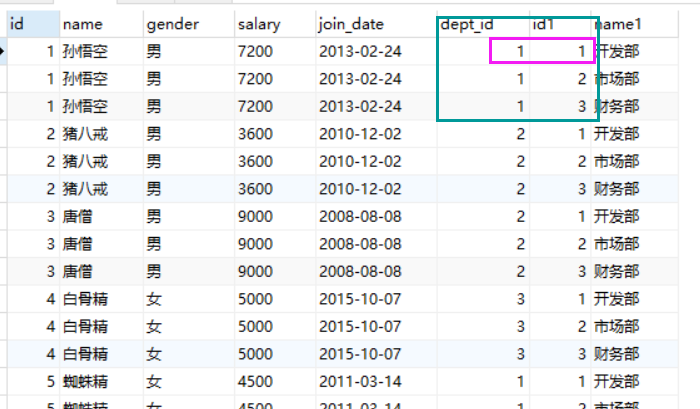
1. Inner connection: use the records of the left table to match the records of the right table. If the conditions are met, it will be displayed (each row of the left table should scan all rows on the right). For example: slave table. Foreign key = primary table. Primary key (the above query is queried through implicit inner connection)
- Implicit inner connection: SELECT Field name FROM Left watch, Right table WHERE conditions
- Show internal connections: SELECT Field name FROM Left table [INNER] JOIN ON condition and where condition in the right table; (where or and can be used for multiple conditions)
- The two are equivalent.
select * from emp e inner join dept d on e.dept_id = d.id where e.name='Tang Monk';
As like as two peas, what is the same?
2. External connection:
Left outer connection: SELECT Field name FROM LEFT [OUTER] JOIN Right table ON condition
Right outer connection: SELECT Field name FROM Left table right [outer] join Right table ON condition
Summary:
Compared with the internal connection, the external connection increases the ability to display all the information of a table without matching. The left outer connection ensures that all of the left table are displayed, and the right outer connection ensures that all of the right table are displayed.
Note: if there is no foreign key constraint between two tables, multi table queries can still be performed.
Subquery: (create a value | set | table before the main query)
According to the results of sub query:
- Single column: SELECT Query field FROM Table WHERE Field = (subquery); (as value)
- Multi column single row: SELECT Query field FROM Table WHERE Field IN (sub query); (as a collection)
- Multiple columns and rows: SELECT Query field FROM (subquery) Table alias WHERE Conditions; (as a table)
Query employees and their corresponding departments after January 1, 2011: (the results of the three queries are the same)
 Note: when a multi row and multi column subquery is used as a table, it must take an alias.
Note: when a multi row and multi column subquery is used as a table, it must take an alias.
practice:
Table emp: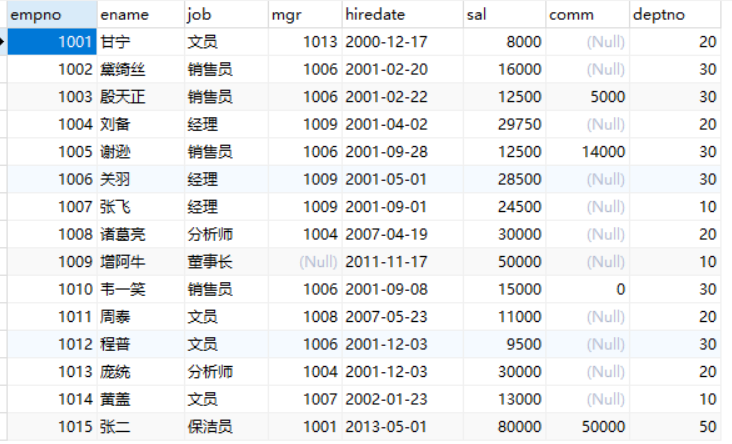
Table dept:
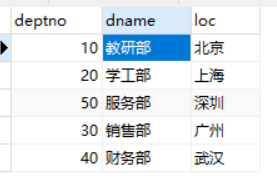
Code: (and symbol is better not used together)
-- 1: Query name is three words and salary sal And bonuses comm Employee information and the name and address of his / her department SELECT emp.*, dept.dname, dept.loc FROM emp LEFT JOIN dept ON (sal + IFNULL(comm, 0)) > 30000 WHERE emp.deptno = dept.deptno AND ename LIKE '___'; -- 2: query emp Each department number in the,Salary and salary of all employees in the Department,Department name of the Department ,Salary and ascending order. SELECT h.deptno, h.dname, IFNULL(h.summ, 0) AS 'Wages and' FROM ( SELECT dept.deptno, dname, sum(sal) summ FROM dept LEFT JOIN emp ON emp.deptno = dept.deptno GROUP BY emp.deptno ) h ORDER BY h.summ ASC; -- Or: SELECT dept.deptno, dname, sum(sal) summ FROM dept LEFT JOIN emp ON emp.deptno = dept.deptno GROUP BY emp.deptno ORDER BY summ DESC; -- 3: query emp Department number in,Number of Chinese staff in the Department,Department location and department name. SELECT dept.deptno, dname, count(job) 'Number of clerks' FROM dept LEFT JOIN emp ON emp.deptno = dept.deptno AND job = 'Clerk' GROUP BY emp.deptno; -- 4: query emp Department number in,All department salaries and,Location of Department,Only the information of salary and the highest two departments is displayed. SELECT dept.deptno, loc, dname, sum(sal) 'Wages and' FROM dept LEFT JOIN emp ON emp.deptno = dept.deptno GROUP BY dept.deptno ORDER BY 'Wages and' DESC LIMIT 0, 2 -- 5: query emp Name of each employee in the,Employee entry date,Employee salary,The name of his leader,Leader's entry date,Leader's salary SELECT ee.ename, ee.hiredate, ee.sal, eer.ename, eer.hiredate, eer.sal FROM emp ee LEFT JOIN emp eer ON ee.mgr = eer.empno; -- 6: On the basis of question 5, find out the information of employees whose entry date is earlier than his leader and whose salary is lower than his leader. SELECT ee.ename, ee.hiredate, ee.sal FROM emp ee LEFT JOIN emp eer ON ee.mgr = eer.empno WHERE ee.hiredate > eer.hiredate AND ee.sal < eer.sal; -- 7: On the basis of question 6, continue to query the employee's department name and department location. SELECT e.*, dept.dname, dept.loc FROM ( SELECT ee.deptno, ee.ename, ee.hiredate, ee.sal FROM emp ee LEFT JOIN emp eer ON ee.mgr = eer.empno WHERE ee.hiredate > eer.hiredate AND ee.sal < eer.sal ) e LEFT JOIN dept ON dept.deptno = e.deptno; -- Or: three meter connection: Note where The statement is written last SELECT ee.ename, ee.hiredate, ee.sal, dept.dname, dept.loc FROM emp ee LEFT JOIN emp eer ON ee.mgr = eer.empno LEFT JOIN dept ON ee.deptno = dept.deptno WHERE ee.hiredate > eer.hiredate AND ee.sal < eer.sal; -- 8: query emp Information of employees whose salary is higher than that of all clerks. SELECT * FROM emp WHERE sal > ( SELECT MAX(emp.sal) FROM emp WHERE job = 'Clerk' ); -- Or: SELECT * FROM emp WHERE sal > ALL ( SELECT sal FROM emp WHERE job = 'Clerk' ); -- 09:Find employment date before 2007-05-01 Employee information for SELECT * FROM emp WHERE hiredate < '2007-05-01'; -- 10:query emp Among the occupations in, the entry date is earlier than 2007-05-01 Number of employees SELECT job, COUNT(*) FROM emp WHERE hiredate < '2007-05-01' GROUP BY job; -- 11:query emp The maximum wage and minimum wage in each department in the, and are arranged in descending order according to the maximum wage and minimum wage difference SELECT emp.deptno, dept.dname, max(sal) 'Maximum wage', MIN(sal) 'Minimum wage', MAX(sal) - MIN(sal) 'Wage difference' FROM dept LEFT JOIN emp ON emp.deptno = dept.deptno GROUP BY emp.deptno ORDER BY (max(sal) - min(sal)) DESC; -- 12:query emp The name, salary, bonus, department name and department location of the middle manager and salesperson. Only the monthly salary, bonus and the information of the lowest three people can be queried SELECT emp.ename, emp.sal, emp.comm, dept.dname, dept.loc, sal + IFNULL(comm, 0) 'bonus+wages' FROM emp LEFT JOIN dept ON job = 'manager' OR 'Clerk' AND emp.deptno = dept.deptno ORDER BY (sal + IFNULL(comm, 0)) ASC LIMIT 0, 3;
Summary: on --- where --- group by --- order by----
View: (to place query results)
Create: create or replace View view name as Query result (with check option)??????
create or replace view ggg0 as SELECT ee.ename 'employee',ee.hiredate 'hiredate01',ee.sal 'sal01',eer.ename 'employer',eer.hiredate 'hiredate02', eer.sal 'sal02' FROM emp ee LEFT join emp eer on ee.mgr = eer.empno;
Delete: drop view view name;
View: show tables;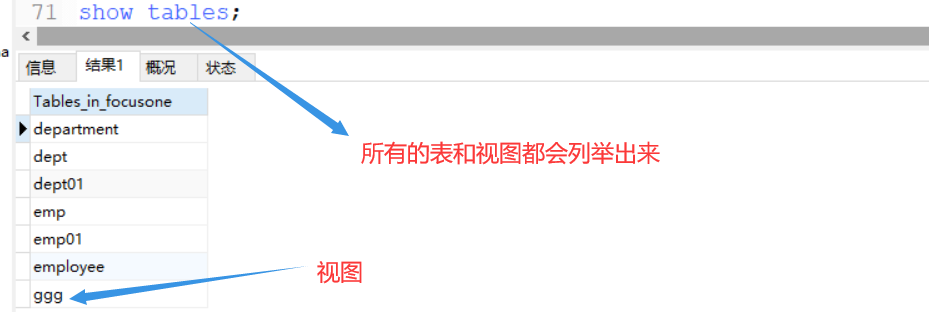
be careful:
- The field names of a view are not allowed to be repeated, but we can when querying (the fields of query results will be modified)
- The content of the view will change according to the content of the queried table.
- Views, like ordinary tables, can be queried by rows.
SELECT * FROM ggg0 ORDER BY sal01 DESC;
Database functions:
1. Function to handle NULL:
ifnull(exper1,exper2): if exper1 is null, exper2 is returned; otherwise, exper1 is returned
nullif(exper1,exper2): if exper1 and exper2 are equal, null is returned; otherwise, exper1 is returned
if(exper1,exper2,exper3): similar to?: For ternary operator, if exper1 is true, not equal to 0 and not equal to null, exper2 is returned; otherwise, exper3 is returned
isnull(exper1): judge whether exper1 is null. If it is null, it returns 1 as the query result, and null returns 0
SELECT NULLIF(111,111);-- NULL
SELECT IFNULL(NULL,5);-- 5
-- 0 perhaps null representative false,1 representative true
SELECT IF(NULL,2,3);-- 3
SELECT IF(0,2,3);-- 3
SELECT IF(1,2,3);-- 2
-- be careful: sql Statement, the Boolean operator equal sign is'=';
SELECT if(CHAR_LENGTH('123456') = 6,'111','222');--111
SELECT if(CHAR_LENGTH('123456') != 6,'111','222');--222
SELECT ISNULL(NULL);--12.case statement: (multiple branches)
First usage:
case value when compare_value1 then result1 when compare_value2 then result2 else result3 end --compare_value1 and compare_value2 All values, If value Equal to who, it will be executed then
Second usage:
case when condition1 then result1 when condition2 then result2 ........ else result end condition1,2 They are Boolean expressions, so they are more flexible than the first method
Example:
3. Common single line functions:
-- 01 char_length(str):Calculated character length:
SELECT
ename,
CHAR_LENGTH(ename) 'length'
FROM
emp;
#Character length, not bytes
-- 02 date_add:Add a date after a certain period of time
-- use date_add The function requires two parameters, date and numeric type, with unit
-- select date_add('1998-01-02',interval 12 month); -- year month day,
-- Find the date after the employee has worked for ten years:
SELECT
ename,
hiredate,
DATE_ADD(hiredate, INTERVAL 10 DAY)
FROM
emp;
-- 03 now() Represents the current year, month, day, hour, minute and second
-- Find employees who have been employed for more than ten years
SELECT
ename hiredate,
DATE_ADD(hiredate, INTERVAL 10 YEAR) 'Time after ten years of employment'
FROM
emp
WHERE
DATE_ADD(hiredate, INTERVAL 10 YEAR) < NOW();
-- 04 Virtual table dual,It can only appear this time. Of course, it can not be written
SELECT
CURDATE(),
CURTIME(),
NOW()
FROM
DUAL;
-- 2021-09-07****12:05:21*****2021-09-07 12:05:21
SELECT
CURDATE(),
CURTIME(),
NOW();
-- The above virtual table may not be writtenOther functions:
Uuid(): uuid() in the same column will not be repeated;
ALTER TABLE emp ADD sss VARCHAR(40); UPDATE emp SET sss = UUID();
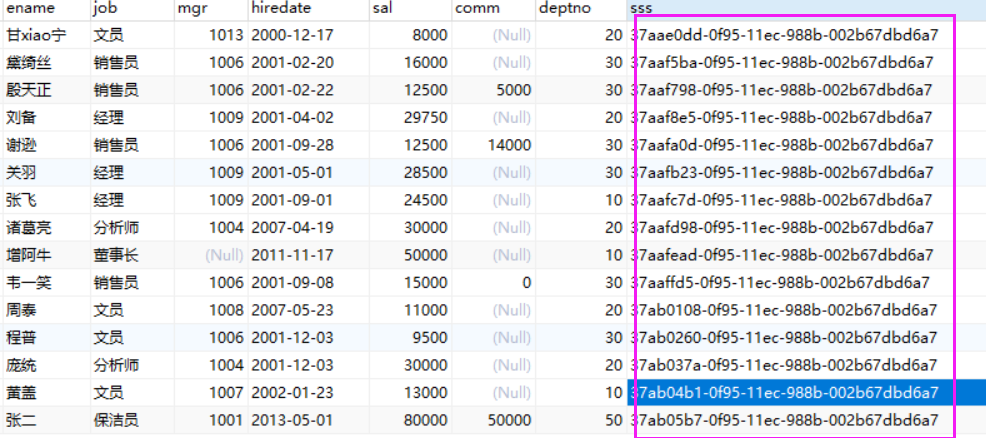
Transaction:
Properties: (ACID)
- atomicity: success or failure;
- consistency: the integrity of data before and after a transaction should be consistent
- Persistence: once a transaction is committed, it is irreversibly persisted to the database.
- isolation: when a user operates a transaction, the database starts a transaction for each user. The transaction cannot be disturbed by the data operated by other transactions.
Some problems caused by poor isolation:
- Dirty read: one transaction reads data that is not committed by another transaction.
- Non repeatable reading: in a transaction, the contents of a row are read multiple times, but the reading results are different.
- Phantom reading (virtual reading): a transaction reads the data inserted by another transaction, resulting in different readings before and after.
Basic syntax of transaction commit
-- use set Statement to change the auto submit mode SET autocommit = 0; /*close*/ SET autocommit = 1; /*open*/ -- be careful: --- 1.MySQL The default is auto submit --- 2.Auto commit should be turned off first when using transactions -- Start a transaction,Mark the starting point of the transaction START TRANSACTION -- Commit a transaction to the database COMMIT -- Rollback transaction,The data returns to the initial state of this transaction ROLLBACK -- reduction MySQL Automatic submission of database SET autocommit =1; -- Save point SAVEPOINT Save point name -- Set a transaction savepoint ROLLBACK TO SAVEPOINT Save point name -- Rollback to savepoint RELEASE SAVEPOINT Save point name -- Delete savepoint
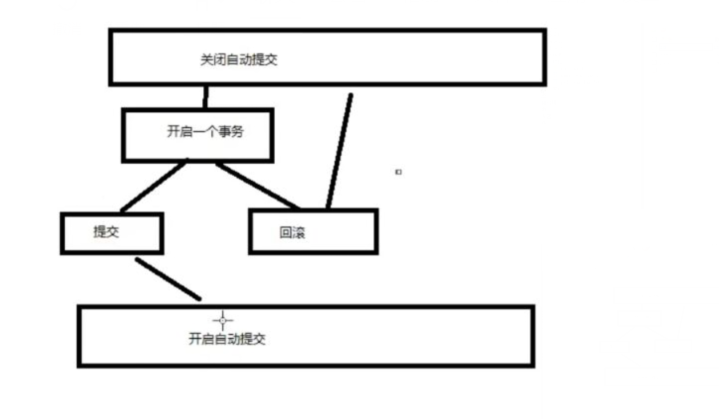
Transfer realization:
CREATE TABLE if not EXISTS shiwu (
id INT PRIMARY KEY auto_increment,-- Constrained by two conditions
name VARCHAR(3) NOT NULL,
cash DECIMAL(7,2) not NULL
);
INSERT INTO shiwu (name,cash)
VALUES('A',2000.00),('B',10000.00);
-- Realize transfer:
set autocommit = 0;
START TRANSACTION;
UPDATE shiwu SET cash=cash+500 WHERE name= 'A';
UPDATE shiwu SET cash=cash-500 WHERE name='B';
COMMIT;
ROLLBACK;
SET autocommit = 1;Stored procedure:
Purpose: a collection of one or more MySQL statements saved for future use. (it can be understood as a method in java)
Format:
drop procedure if exists Stored procedure name; create procedure Stored procedure name(pram[parameter list]) begin sql sentence end; Used in parameter list in Keywords represent input parameters ,use out Keyword represents the return value format: in Parameter type out Parameter type Call: call Stored procedure name(Input reference 1,Input reference 2,....@Return value); select @Return value; -- delete drop procedure Stored procedure name;
Example: creating a stored procedure:
drop PROCEDURE IF EXISTS foo;
-- Create function:
CREATE PROCEDURE foo (in newname VARCHAR(20),in dis VARCHAR(100),OUT sum INT)
BEGIN
INSERT into tsinger(sname,display) VALUES (newname,dis);
SET sum = (SELECT COUNT(*) FROM tsinger);-- Assignment must be in parentheses
END;
-- Call function
call foo('lll','cekhhkb',@cou);
SELECT @cou;-- Query return value
Note: not all sql statements (ordinary sql statements) in storage functions end with semicolons, but sql statements in stored procedures end with semicolons in navicat. Other software may not!!!
Declare variables:
1. Declare variables with declare
declare variable name type default initial value;
2. Use set to declare variables. The values of variables can come from subqueries
set @ variable = (query); (Note: use this variable with @)
Assignment:
set variable = value;
Branch:
If condition then operation end if;
If condition then operation else operation end if;
Note: there are no if... if... else or if... Else or if... Else molecular statements in sql branch statements, only the above two. If you need more branches, you need to use the case...when statement.
Cycle:
- while statement
While condition do operation end while;
2.repeat statement Similar to do while in java, it is executed first whether the condition is true or not
Repeat operation until condition end repeat;
# Create the stored procedure pro2, specify the name and description, add a new singer, and return the number of singers whose salary is null
drop PROCEDURE if EXISTS pro2;
create procedure pro2(in spc_name varchar(20),in spc_display varchar(100),out count int)
BEGIN
# When the specified name is null, it is set to system test + random string
if ISNULL(spc_name)
then set spc_name = concat('System test',SUBSTR(UUID(),1,8));
end if;
insert into tsinger (sname , display) values (spc_name,spc_display);
set count = (select count(*) from tsinger where salary is null);
end;
# Stored procedure 3: modify the salary with null salary to the smallest salary in the table
drop procedure if exists pro3;
create procedure pro3()
BEGIN
set @min_sal = (select min(salary) from tsinger);
update tsinger set salary = @min_sal where salary is null;
end;
call pro3();
# Stored procedure 4: add a singer according to the specified gender
# If the gender is' female ', set salary to 10000
# If the gender is male, set salary to the smallest salary in the table
drop PROCEDURE if EXISTS pro4;
CREATE PROCEDURE pro4(in sex char(1))
BEGIN
set @minsalary = (SELECT min(salary) from tsinger);
if(sex = 'male') THEN
INSERT tsinger(sex,salary) VALUES ('male',@minsalary);
else
INSERT tsinger(sex,salary) VALUES ('female',10000) ;
end if;
end;
call pro5('male');
call pro4('female');
-- use case when sentence
drop PROCEDURE if EXISTS pro4;
create procedure pro5(in sex1 char(1))
BEGIN
DECLARE salary1 int DEFAULT 0;
set @minsalary = (SELECT min(salary) from tsinger);
case
when sex1 = 'male' then set salary1 = @minsalary;
when sex1 = 'female' then SET salary1 = 10000;
ELSE set salary1 = null;
end case;-- Conflict with Terminator
INSERT into tsinger(sex,salary) VALUES (sex1,salary1);
end;
# Stored procedure 5: insert a specified number of records into the tsinger table. The name and description are uuid random, and the gender is' female 'and' male '
drop PROCEDURE IF EXISTS pro5;
create PROCEDURE pro5(in count int)
BEGIN
declare a int default 1;
declare gender char(1) default 'female';
while a<=count DO
if a%2!=0 then set gender = 'female';
else set gender = 'male';
end if;
insert into tsinger (sname,sex,display) values (SUBSTR(UUID(),1,8),gender,UUID());
set a = a+1;
end while;
end;
call pro5(4);
# Stored procedure 6: insert a specified number of records into the tsinger table, and sname takes random
drop PROCEDURE if exists pro6;
create procedure pro6(in count int)
BEGIN
repeat
insert into tsinger (sname) values (SUBSTR(UUID(),1,8));
set count = count +1;
until count>=10 end repeat;
end;
# 100 has met the condition of > = 10 to stop the cycle, but it is still executed once
call pro6(100);Summary:
- When writing sql functions, variables are usually declared first through declare or set. During this period, most operations are on these variables (and formal parameters declared in begin and end), and finally on the specific fields and records of the specific table.
- The formal parameters in sql stored procedures and the values in begin...end can be the same as the field names in the operation table, but it is better not to be the same
Stored procedures with transactions:
Design a stored procedure with transaction processing. -- modify tsinger Table assignment sid The record of display Specified for the new display,--Errors may occur, so a transaction needs to be established -- modify tsinger If the salary is less than or equal to 10000, multiply it by 3,If the salary is more than 10000, multiply it by 0.9 -- Return the total number of singers whose monthly salary is more than 10000 in the table. drop PROCEDURE if EXISTS pro10; CREATE PROCEDURE pro10 (in sidp INT,in newdisplay VARCHAR(20),OUT sum INT) BEGIN -- Declare state variables: DECLARE flag int DEFAULT 1; -- statement sql Exception handler, error sql In case of abnormality, set flag = 0; DECLARE CONTINUE HANDLER for SQLEXCEPTION SET flag = 0; -- Transaction: modification may violate unique constraints START TRANSACTION; UPDATE tsinger SET display = newdisplay WHERE sid = sidp; UPDATE tsinger set salary = salary *3 WHERE salary < 10000; UPDATE tsinger set salary = salary*0.9 WHERE salary >10000; if flag = 1 THEN COMMIT; ELSE ROLLBACK; end IF; set sum = (SELECT COUNT(*) FROM tsinger WHERE salary>10000); end; call pro10(1002,'kkjg',@sum); SELECT @sum;
Cursor:
# Use cursors in stored procedures: # Calculate the sum of salary in tsinger and return it. When display in the record is null, it is set to the random string uuid drop procedure if exists pro_cursor; create procedure pro_cursor(out sum decimal(11,2)) BEGIN declare flag int default 1; declare singer_id int default 0; declare singer_sal decimal(7,2) default 0; declare singer_dis varchar(100) default '';-- ''be equal to null # Declare cursor cur1 declare cur1 cursor for select sid,salary,display from tsinger;-- Cursor based on a query declare continue handler for not found set flag = 0;-- Set a processor when it cannot be found set sum = 0; # Open cursor open cur1; # Fetch data from cursor fetch cur1 into singer_id,singer_sal,singer_dis; # Cyclic operation while flag = 1 do if singer_sal is not null then set sum = sum + singer_sal; end if; if singer_dis is null then update tsinger set display = UUID() where sid = singer_id;-- Don't write where The fields are all updated end if; # The cursor continues down fetch cur1 into singer_id,singer_sal,singer_dis; end while; # Close cursor close cur1; end; CALL pro_cursor(@summm); SELECT @summm;
Trigger: (similar to the listener in GUI)
Create: create trigger trigger_name trigger_time trigger_event on table_name for each row
Triggers are database objects related to table operations, so the names of triggers are related to tables. When creating triggers, you need to specify the table name table_name, the table is permanent, so the trigger cannot be associated with temporary tables and views.
Trigger: key to create trigger and define trigger name.
trigger_name: the name of the trigger.
trigger_time: the execution time of the trigger. Its value is before or after, which refers to whether it is executed before or after the statement that activates it. Generally, the trigger is executed after the statement that activates it is completed.
trigger_event: trigger event. Its value can make insert, update and delete. For these three actions, we need to understand the two temporary virtual tables in the database: deleted and inserted, which are represented by the old and new keywords in mysql. (dialect) (the names of the fields in the new table and the old table are the same as those in the table with triggers).
for each Row: add a trigger action for each row. It will be triggered as long as it is changed.
For each line, first sense whether there is a modification operation = = > trigger = = > before? Update to table after.
| action | deleted table (old) | inserted table (new) |
| insert | Do not store records | Store newly inserted records |
| update | Records before storage | Store updated records |
| delete | Store deleted records | Do not store records |
Delete: drop trigger name;
View: show triggers;
drop table if exists trecord; create table trecord( rid varchar(32) primary key, -- Primary key sid int , -- singer id sname varchar(20), -- Singer name display varchar(100), -- Singer description newdisplay varchar(100), -- New description of singer updatetime datetime -- Modification time ); DROP TRIGGER update_display_record; CREATE TRIGGER update_display_record AFTER UPDATE ON tsinger FOR EACH ROW BEGIN DECLARE rid VARCHAR (32) DEFAULT ''; SET rid = REPLACE (UUID(), '-', ''); INSERT INTO trecord VALUES ( rid, old.sid,-- These are the values of the corresponding rows old.sname, old.display, new.display, now() ); END;
Example:
Design a trigger , In the direction tsinger When inserting data into a table,If salary No value given or less than 500,It is assigned 1000.01, -- If birthday No value given,It is assigned as the current date DROP TRIGGER if EXISTS pro9; CREATE TRIGGER pro9 BEFORE INSERT ON tsinger FOR EACH row BEGIN if new.salary < 500 or new.salary is null THEN SET new.salary = 1000.01; end if; if new.birthday is NULL then set new.birthday = NOW();-- birthday Is a string, so it can be followed by a date; end if; END; INSERT into tsinger(salary,birthday) VALUES (500,NULL); INSERT into tsinger(salary,birthday) VALUES (400,NULL);

